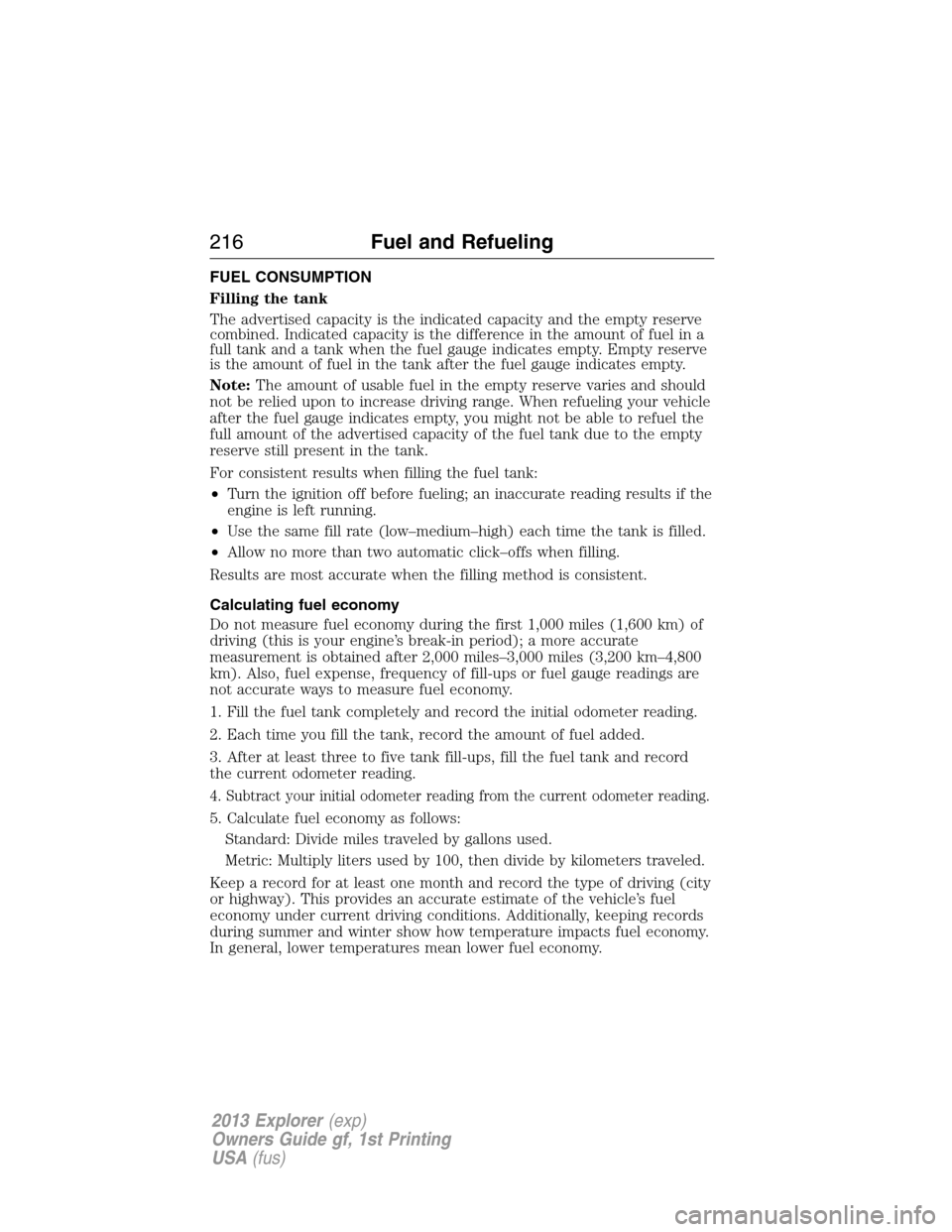Page 216 of 576

FUEL CONSUMPTION
Filling the tank
The advertised capacity is the indicated capacity and the empty reserve
combined. Indicated capacity is the difference in the amount of fuel in a
full tank and a tank when the fuel gauge indicates empty. Empty reserve
is the amount of fuel in the tank after the fuel gauge indicates empty.
Note:The amount of usable fuel in the empty reserve varies and should
not be relied upon to increase driving range. When refueling your vehicle
after the fuel gauge indicates empty, you might not be able to refuel the
full amount of the advertised capacity of the fuel tank due to the empty
reserve still present in the tank.
For consistent results when filling the fuel tank:
•Turn the ignition off before fueling; an inaccurate reading results if the
engine is left running.
•Use the same fill rate (low–medium–high) each time the tank is filled.
•Allow no more than two automatic click–offs when filling.
Results are most accurate when the filling method is consistent.
Calculating fuel economy
Do not measure fuel economy during the first 1,000 miles (1,600 km) of
driving (this is your engine’s break-in period); a more accurate
measurement is obtained after 2,000 miles–3,000 miles (3,200 km–4,800
km). Also, fuel expense, frequency of fill-ups or fuel gauge readings are
not accurate ways to measure fuel economy.
1. Fill the fuel tank completely and record the initial odometer reading.
2. Each time you fill the tank, record the amount of fuel added.
3. After at least three to five tank fill-ups, fill the fuel tank and record
the current odometer reading.
4. Subtract your initial odometer reading from the current odometer reading.
5. Calculate fuel economy as follows:
Standard: Divide miles traveled by gallons used.
Metric: Multiply liters used by 100, then divide by kilometers traveled.
Keep a record for at least one month and record the type of driving (city
or highway). This provides an accurate estimate of the vehicle’s fuel
economy under current driving conditions. Additionally, keeping records
during summer and winter show how temperature impacts fuel economy.
In general, lower temperatures mean lower fuel economy.
216Fuel and Refueling
2013 Explorer(exp)
Owners Guide gf, 1st Printing
USA(fus)
Page 395 of 576

Item CapacityFord Part Name or
equivalentFord Part Number / Ford
Specification
Automatic
transmission fluid
5,6
10.8 quarts
(10.3L)
(6F50)
Motorcraft�
MERCON�LV AT FXT-10-QLV /
MERCON�LV 11.6 quarts
(11.0L)
(6F55)
9.0 quarts (8.5L)
(6F35)
Rear axle fluid 2.4 pints (1.15L)Motorcraft�SAE
80W-90 Premium Rear
Axle LubricantXY-80W90-QL /
WSP-M2C197-A
Windshield washer
fluidFill as requiredMotorcraft�Premium
Windshield Washer
Concentrate (US)
Premium Quality
Windshield Washer
Fluid (Canada)ZC-32-A (US)
CXC-37-(A, B, D, and F) (Canada)
/
WSB-M8B16-A2/- -
Fuel tank18.6 gallons
(70.4L)——
1Use only Motorcraft�DOT 4 LV High Performance Brake Fluid or equivalent meeting WSS-M6C65-A2
and ISO 4925 Class 6. Use of any fluid other than the recommended fluid may cause brake system
damage.2Add the coolant type originally equipped in your vehicle.3Use of synthetic or synthetic blend motor oil is not mandatory. Engine oil need only meet the
requirements of Ford specification WSS-M2C946-A, SAE 5W-30, or WSS-M2C945-A, SAE 5-W20, and
display the API Certification Mark.
Capacities and Specifications395
2013 Explorer(exp)
Owners Guide gf, 1st Printing
USA(fus)
Page 396 of 576
Item CapacityFord Part Name or
equivalentFord Part Number / Ford
Specification
4Your engine has been designed to be used with Ford engine oil, which gives a fuel economy benefit
while maintaining the durability of your engine.
Using oils other than the one specified can result in longer engine cranking periods, reduced engine
performance, reduced fuel economy and increased emission levels.5Indicates only approximate dry-fill capacity. Some applications may vary based on cooler size and if
equipped with an in-tank cooler. The amount of transmission fluid and fluid level should be checked
by a qualified technician.6Use of a dual usage fluid in an automatic transmission requiring MERCON�LV may cause
transmission damage. Use of any fluid other than the recommended fluid may cause transmission
damage. Refer toscheduled maintenance informationto determine the correct service interval.
396Capacities and Specifications
2013 Explorer(exp)
Owners Guide gf, 1st Printing
USA(fus)